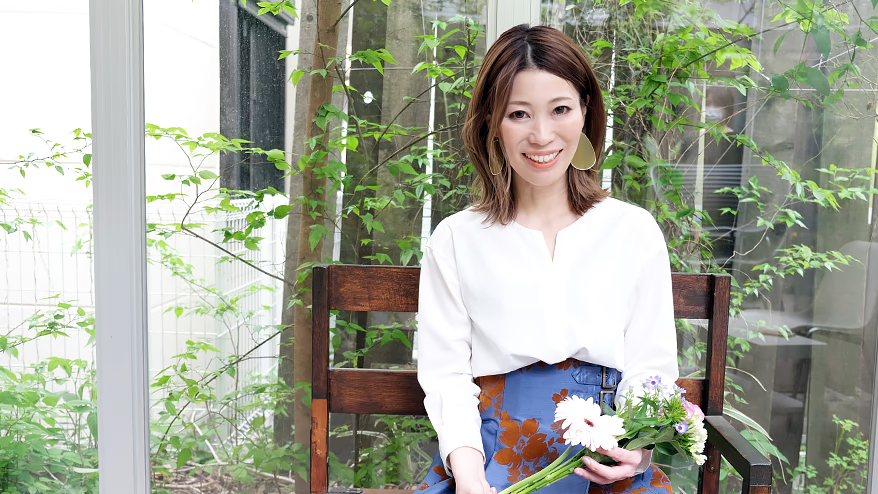こんにちは。京都在住のライター・杉本です。
ものさすサイトのお手伝いをはじめてもう1年になりました。
モノサスがフルフレックス制度を導入して4年目、そしてフルリモートになってもう1年。働く時間と場所を自分たちで決められるようになり、モノサスのメンバーはどんなふうに、自律したワークスタイルをつくっているのでしょう。そして、個として働く時間が多くなるなか「会社」という場、あるいは組織に対する意識はどう変化しているのでしょうか?
「自由と責任 みんなの制度と働き方実験室」は、社員のみなさんに今の働き方をざっくばらんに話してもらうインタビュー連載です。今回は、Webデザイナーの滝田怜子さん。いきなりお花を渡してプロフィール写真を撮影するという、むちゃぶりな幕開けになりました!
(※ちなみにこのお花は、代々木散策マップの降旗ゆかりさんの記事を見てランチしに行ったお店で、生花農家支援のために販売されていたものです)
フルリモートOKになってもあえて出勤したい理由
杉本:2017年4月、ちょうどフルフレックス制度が導入された頃に、ものさすサイトに書かれていた記事のなかに、滝田さん自身をペルソナとして「アプリを使うはたらく女子像」があったのですが……。
滝田:えっ、ちょっと見ていいですか? あーーー!この頃の記憶がないです。ちょっと忙しすぎたのかも(笑)。
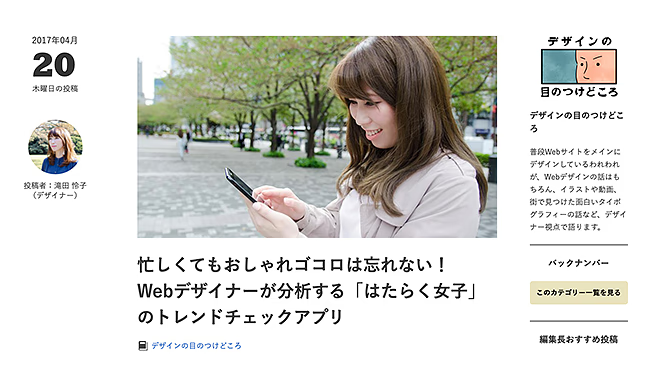
杉本:「朝8時起床、1時間かけて通勤して11時に出社、週3回くらい残業」と書いていたのは、フレックスになっていたからなのかなと思いました。今も、同じようなサイクルで働いていますか?
滝田:今はもっと自由にしていますね。朝はダラダラしたいタイプなので、メールをチェックして、前夜にシャワーを浴びながら「こうしたら解決するじゃん!」と気づいたことをちょちょっとやって。お昼を食べてから出勤して本気モード、みたいなサイクルになりつつあります。私は、組織に所属しているなら周りの人から情報や知識を得るという恩恵を受けていたいタイプなので、上司の出勤日に合わせて出社するようにもしていました。
杉本:フルリモートになっても、会社で仕事をしたいんですね。
滝田:モノサスに所属しているのは、ここにいる人たちと話すことでプラスになっていると思うから。出社しないとなると自分のなかでこの組織に身を置いているという意義が薄れすぎちゃうなと思うんです。
私はそれぞれの集中力を大事にしたいので、上司が飲み物を入れに行くのを見て「今は集中力が途切れているタイミングだろうから席に戻られたら質問しよう」とか、相手の都合の良さそうなタイミングで話しかけています。近くにいればそんな様子も伺いとれますし、ちょっとした雑談からヒントをもらえることもあります。会社としてはリモートに移行する方向だと思うけれど、ひとり暮らしで集中できる環境ができたとしても会社には来ると思いますね。
“迷いの森”から抜け出すポイントは駐輪場とシャワー!?
杉本:滝田さんの働き方は、「午前中はリラックスして前日にやり残したことをやって、午後は集中する」というように、一日のなかに上手に緩急をつくっているようにも感じました。
滝田:そうですねえ。「抜く」タイミングは意識しているかもしれません。お昼も集中力が切れたタイミングで出て、コーヒーを飲みながらぼーっとできる場所で一回頭を仕事から離すようにしています。自分では“迷いの森”って呼んでいるんですけど、ずっと同じことを考え続けているとわからなくなってしまうので、ちょっと離れてから見直すと「ちゃんと成立しているし、ルール通りになっている!」ってことがけっこうあります。
杉本:夜にシャワーを浴びているときに「こうしたら解決するじゃん」って気づくと言われていましたが、家に帰っても仕事のことを考えちゃうんですか?
滝田:常に「どうしよう?」と悩んでいるわけではないのですが、帰る途中の駐輪場やシャワーを浴びているときとか、なんかふっとくるポイントがあるんですよね。
相手のことがわかって「うまくいってるぞ」と感じるのが好き
杉本:フルリモートになってから、クライアントとのコミュニケーションはどんな風に変化していますか?
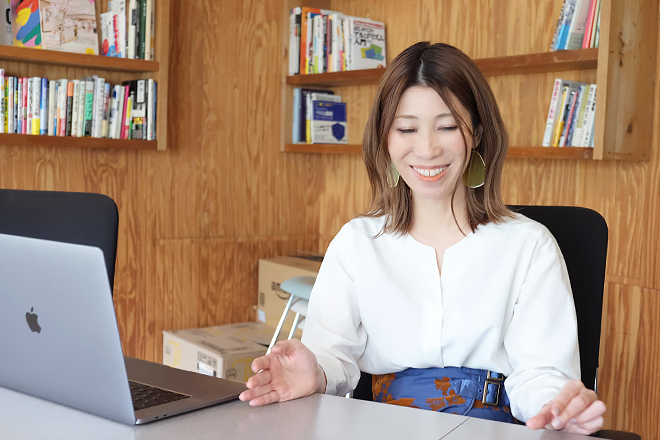
滝田:基本はオンラインになりました。Web会議のときにどんな話し方をされるのか、どういう場所から接続されているのかを見て、相手を知ろうとすることはあります。テキストベースのコミュニケーションでは、たとえば文末に「!」をつけてみて、ちょっとテンションが高いお返事をいただけるかどうか、とか。相手が喜ぶようなコミュニケーションが取るために小さな実験をしたりしますね。
担当者さんが、どんな進め方をしたら「スムーズだな」と感じてくれるのか、どのタイミングでていねいな補足をつけて提出物を出したら「すごくやりやすい!」と思ってくれるのか。キャッチボールしながら相手のことがわかってきて「よしよし、うまくいってるぞ」と感じることが好きなんだと思います。
杉本:そっか。さっきの「上司にいつ話しかけるか」という話もそうですけど、コミュニケーションの最適解を考えるのが好きなんですね。社内のみなさんとのコミュニケーションについては、どんな変化がありますか?
滝田:ほとんどの人と会えなくなっているなかで、全体会議後の全員会議が楽しいと感じるようになっているんじゃないかと思っていて。以前は「全員会議はなくてもいい」という人もいただろうし、絶対話さなければいけないことがプレッシャーになっている人もいたと思うんです。でも、やっぱりどこかみんなに「ちょっとしゃべりたい欲」みたいなのが溜まってきていて、みんなしゃべるようになってきたなと思います。
たとえばですけど、全然違うテーマで話していたときに、誰かが「最近人に褒められてないなあ」と言い始めて。「大久保さんって、会うといつも『今日の服いいね!』『今日はなんか元気そうだね』って必ず褒めてくれるよね」「褒められたいって思ったら、大久保さんの顔を思い出したわ」ってなって、みんなで大久保さんの存在ってすごくありがたいねえって話していました。
なんかこう、全員会議があることで、全員が会社の人を思い浮かべる瞬間があるのは、リモートになってあらためてありがたみを感じたかなと思います。
UX/UIデザインという方向性が見えてきた頃のこと
杉本:そういえば、ものさすサイトに載っていた、2017年9月に、滝田さんがMVPを受賞されたときの小野木さんのメッセージにじんわりきました。クールで論理的な雰囲気の小野木さんですが、ハートはあたたかいんだなぁ、と。
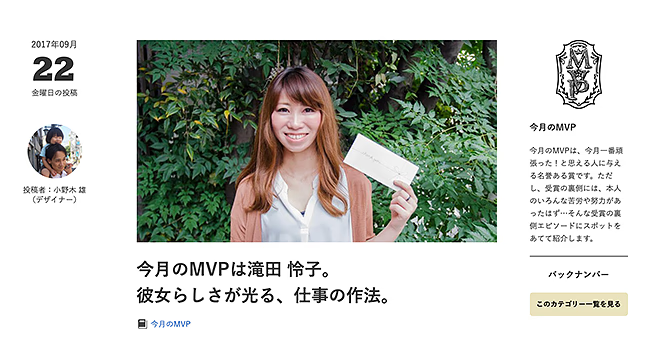
滝田:あれは泣きましたね。そんなにちゃんと見て分析してくれる人がいるんだって。自分で自分の長所を自覚しづらいタイプなので、ああいう風にヒントをもらえた経験が、その後に大きな糧にもなりました。小野木さんは、私やほかの後輩に問題が起きたときも、解決の導き出し方がやさしくて、一番信頼している上司です。
杉本:モノサス入社6年目だった2018年には「異業種からのデザイナー転職記」という記事で、「『どんなデザイナーになりたいか』『どんな仕事をやってみたいか』という方向性を含めたスキルアップを考えるように」なったと書かれていました。
滝田:そう書きたかった部分もあったんだと思います(笑)。デザイナーと言っても、視覚的に優れたものをつくるのが得意な人もいれば、Webの使い勝手の良さやわかりやすさを考えるのが得意な人もいます。「どちらかというと私は後者を目指そう」と思い始めたのがたぶんその頃でした。ちょうどUX/UI(User Experience/User Interface)という言葉が出はじめて、自分が目指すのはそっちかなというのが見え始めたんですね。
杉本:なぜ、そう思われたんですか?
滝田:当時在籍していた、視覚的に優れたデザインをつくるのが得意な先輩を見ていて、「自分はこういう方向で行くよりも、設計の部分をデザインして『これをきれいにしてください』と渡したほうがいいものをつくれるんじゃないか」と思ったのもあります。
また、UX/UI改善のプロジェクトで、UXディレクターとして有名な株式会社ツルカメの森田雄さんと少しだけご一緒させていただく機会があって。Webに限らず自分たちが使うツールの使い勝手の良さを考えるUX/UIデザインの方を目指したいというのは、この案件で大きく変わったところだったと思います。
杉本:クライアントや社内とのコミュニケーションの話を聞いても、滝田さん人に興味があるんだなぁと思いました。UX/UIデザインの仕事、もっとしたいんじゃないですか?
滝田:やりたいですね!ゼロからUX/UIデザインをする仕事で経験を積んで、「さあこれから私はこれで稼ぐぞ」みたいにやりたい。だから、全員会議で営業さんに「UX/UIの上流からの仕事をやりたいです」って言ったりしています。
また変わろうとしているモノサスをもうちょっと見ていたい
杉本:デザインのお仕事もいろいろあるけれど、もしかしたら滝田さんがデザインしているのは人と人のコミュニケーションそのものかもしれないですね。
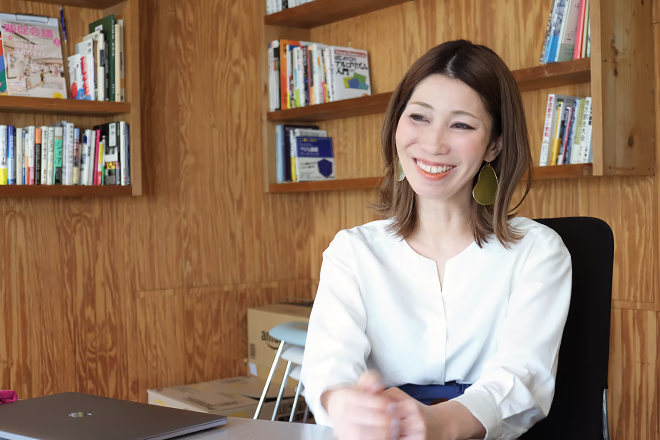
滝田:あぁ……、なんかいい言葉ですね。
杉本:デザインというと、見た目をきれいにつくる仕事だと思われがちだけど、もっと本質の部分からデザインを立ち上げようとしている印象を受けました。
滝田:Webサイトをつくるにしても、全体のプロセスのなかでデザインって一部分だけですし、手をつなぐのがうまい人がいないとうまく回らないと思うんですよね。工程を分断して「ここから先はコーダーに丸投げ」とするのではなく、間をつなぐディレクター的な要素はみんながもっていたほうがいいなと思ったりしています。家に引きこもって作業をする人たちとも連絡はとりあえるけれど、ちょっと意識してコミュニケーションをとるだけでも、モノサスの仕事はもっとうまく回るような気がしています。
杉本:入社10年目である程度実力もついてきて、フルフレックスでフルリモートとなると、働き方はフリーランスと変わらないのでは?と思います。それでもモノサスで働きたいと思う意義ってなんですか?
滝田:尊敬する上司がいるのはひとつ大きな理由ですね。また、モノサスって常に変化を繰り返してきたけれど、今はまた少し変わろうとしていると感じるタイミングで。Webだけやっていれば会社が存続できる時代でもないだろうというなかで、いろんなビジョンをもっている人たちがいるモノサスをもうちょっと見ていたいし、自分もそこに身を置いていたいとも思っています。
杉本:Web制作の会社かと思っていたらものさす社食研ができたり、「何するんだろう?」って思いますよね。
滝田:いきなり農家の部長が出てきたり、隣が急にパン屋になったりって、普通はありえないじゃないですか。真鍋さんを中心に、食に関心のある人たちが事業を広げていくのであれば、Webのほうでも私がやりたいような仕事に巻き込んでもらえるチャンスがまだあるな、と思っています。
「相手をちゃんと見て、心地よいコミュニケーションをつくる」ってすごくクリエイティブだし、実は誰にでもできることじゃないと思います。お話を聞いていて、滝田さんがUX/UIデザインを手がけたWebやアプリ、めちゃくちゃ触ってみたくなりました。早くできないかな! なんて思いつつ、モノサスのエントランスに出たら「尊敬されている上司・小野木さん」にばったり出会いました。
「小野木さん!滝田さんがめっちゃほめてましたよー」「ほら、写真めっちゃきれいに撮れたから見てください」とじゃれついてみたら、ふっとクールに笑った小野木さん。「おれさー、滝田がガングロだった頃の写真見たことあるよ」と突然の自慢(?)……。きっと、滝田さんを美しく撮影した私にジェラシーを感じたのだろうと理解しました。なーんて勝手なことを書いて記事を仕上げて、なにげなくFacebookを開いたら小野木さんから友だちリクエストが!正直ビビりましたが、つまりはふたりって本当にいい上司と部下の関係なんだと思います。
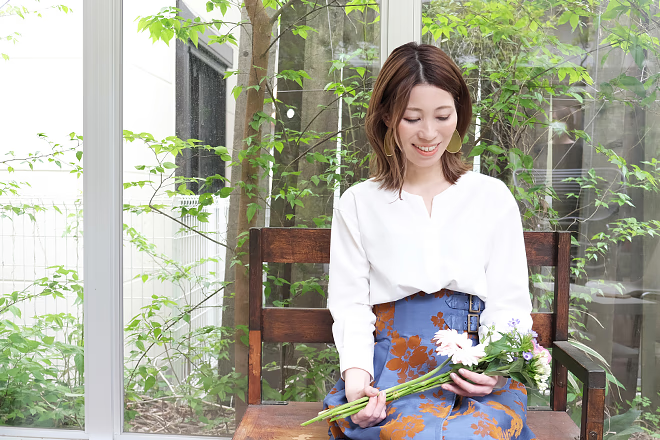 「お見合い写真に使います!」と言われたベストショットからもう一枚。花がお似合いです!
「お見合い写真に使います!」と言われたベストショットからもう一枚。花がお似合いです!
